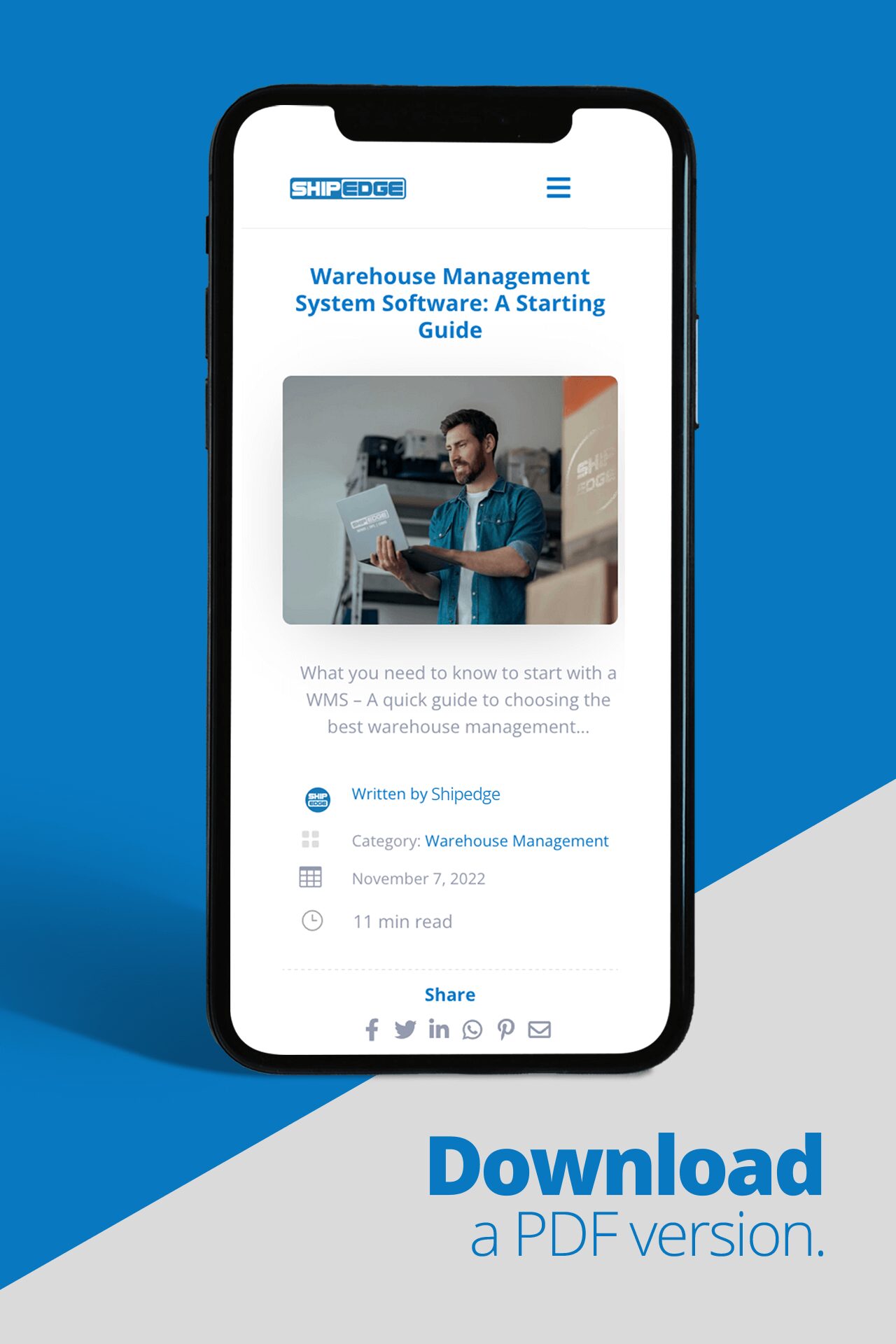Nowadays, modern warehouse systems need to increasingly adapt to evolving technologies to better and more quickly respond to the diverse needs of their customers and thereby achieve optimized and swift market responses, maintaining their performance.
This article will present ten essential tools that a warehouse should have in its arsenal. Also, discover Shipedge WMS – a warehouse management system that can significantly change the course of your company.
What is a warehouse management system?
A Warehouse Management System (WMS) is the software utilized by the manufacturing and retail industries. It provides visibility into a company’s entire inventory, enhancing the management of supply chain procedures from when goods and materials are received in a warehouse to when they are dispatched to fulfill orders.
A WMS can function as a standalone system or work alongside an Enterprise Resource Planning (ERP) system, with integrations to other modules such as:
- Accounting
- Order management systems (OMS)
- Material requirement
- Planning
- Customer relationship management (CRM)
A Warehouse Management System is an automated technology that assists warehouse managers in planning, organizing, staffing, and controlling resources across the supply chain using real-time data. These systems can streamline your organization’s workflow, increasing productivity and efficiency.
READ MORE: Warehouse Management System Software: a Starting Guide
A Warehouse Management System (WMS) assists in simplifying tasks such as receiving, recording, and storing products and inventory using intelligent functions. These systems can streamline your organization’s workflow, increasing productivity and efficiency in a logical manner. This helps reduce costs and optimize all warehouse processes. To maximize warehouse process optimizations, Shipedge has prepared the following guide presenting ten essential tools that a Warehouse Management System should have today.
Discover how our WMS can improve your business
Ten Essential Components for an Up-to-Date Warehouse Management System
1 – Automation Features
Today, technology is making warehouse processes increasingly efficient by reducing the need for human labor by automating repetitive tasks. For this reason, many jobs have sought to focus their efforts on more complex tasks. Seeking to automate your warehouse can be a determining factor for any company.
Warehouse automation can be defined as:
The revolution of inventory movement within and outside warehouses for consumers with minimal human intervention.
By using warehouse automation tools, a company can achieve several advantages, including:
Decreased frequency of mistakes
Sending incorrect orders to customers can hurt their trust. Warehouse automation can help avoid this problem by reducing the number of decisions made by employees and eliminating errors in picking and packing in the warehouse, thereby improving order accuracy.
With an automated system, detecting errors that may occur is much easier as these systems can identify and correct them more quickly.
READ MORE: 7 Effective Picking Methods for Maximizing Warehouse Efficiency
Enhance Employee Productivity
Automation doesn’t necessarily mean that robots entirely replace humans. The implementation of an automation system means to:
Improve customer satisfaction levels by assisting workers to complete their tasks effectively and as quickly as possible.
In practice, warehouse automation can become extremely useful, especially during high workloads, such as holidays, or peak shopping times like Black Friday, Christmas, or Thanksgiving. Another advantage of automation is that it can significantly help reduce recruitment costs by minimizing the need for temporary workers, which can sometimes be challenging to recruit. Finally, and no less important, during times when business is slow, this tool can be important for reducing production volume as needed.
READ MORE: 7 Tips on Preparing for the E-commerce Holidays
Maximize the use of space
Innovative storage solutions can maximize warehouse space. One of the main ways warehouses can achieve this is by making aisles narrower. If using robots or machines to do picking, they may not necessarily need as much space to get around as humans do.
This can improve the management of warehouse space utilization.
READ MORE: The Role of Warehouse Automation in Reducing Operational Costs
Reduce operational costs
Investing in warehouse automation can be complex and expensive initially. However, the crucial question is:
What will be the long-term profitability of this investment?
While the benefits may take time to become apparent, this experience can become highly profitable for businesses. For example, implementing warehouse management software can help reduce various costs:
- Reduction in administrative and staffing costs: Automating routine and repetitive tasks can reduce the need for labor, thereby reducing costs associated with administration and personnel;
- Reduction in storage management costs: An automated warehouse management system can optimize the use of available space, maximizing storage capacity. This can result in space savings and possibly lower rental or maintenance costs;
- Reduction in inventory errors: Automating the stock tracking and inventory management process can help prevent human errors, such as incorrect counting or product loss. This can reduce financial losses caused by inaccurate inventories or lost items.
Discover how our WMS can improve your business
These benefits can positively impact long-term profitability by eliminating the risks of failures or product losses. However, it is essential to consider factors such as the initial implementation cost, employee adaptation, and ongoing system maintenance when evaluating the financial viability of this investment.
Improve customer satisfaction
In the increasingly competitive industry, achieving a high customer experience is crucial for satisfaction. Companies are becoming more proactive in delivering orders for whatever the consumer can imagine.
With an automated warehouse, the order preparation and delivery time will be reduced, and the likelihood of making mistakes approaches zero.
If a customer is unsatisfied with an item, the return process management will be automatic.
Therefore, companies must seek to maintain their loyalty standards so that customers have positive experiences and always want to buy from that supplier. This will simultaneously increase and improve business performance. Ultimately, one of the main reasons large logistics companies invest in developing systematized warehouses and logistics is primarily to improve operational efficiency and better understand the needs of their customers.

2 – Kitting
Kitting refers to combining multiple items into one package or product ready for shipping.
This process is used for various purposes, including:
- Create customized product bundles
- Streamline inventory management
- Reduce shipping expenses
Kitting in a warehouse can bring many advantages, such as:
Boosted revenue
By providing customized packages or product bundles, you can entice new customers and motivate current customers to make additional purchases.
Kitting manufacturing enables you to highlight related products and promote complementary items, resulting in greater average order values and increased revenue.
Streamline Inventory Management
Kitting simplifies your inventory management by optimizing your storage and stocking processes. This can be achieved by implementing an efficient inventory system that tracks real-time product levels and movement. Doing so can reduce the risk of stockouts or overstocking, minimize storage costs, and improve overall operational efficiency.
Lowering shipping and seller expenses
Consolidating various products into one package can reduce shipping fees, especially if the package can be shipped more condensed and effectively. This can help minimize the shipping expenses for your clients.
Additionally, when selling on online eCommerce platforms, sellers may see a reduction in total costs by listing two items as a bundle, or kit, due to a higher price point on the listing leading to a lower percentage charged in most marketplaces.

Discover how our WMS can improve your business
Enhancing customer satisfaction
By offering customers the option to purchase multiple items in a single transaction, you can significantly improve their shopping experience. Kitting manufacturing can also help reduce the likelihood of errors during the ordering process, increasing consumer confidence.
READ MORE: The power of Kitting with Shipedge’s Warehouse Management System
By integrating kitting into your e-commerce business plan, you can gain a notable edge over your competitors. Providing exclusive combinations of products allows you to distinguish your brand from others while also catering to your customer’s unique demands and preferences. Discover the full potential of this innovative strategy today with Shipedge’s advanced WMS solution.
3 – Light Manufacturing
Light manufacturing in a warehouse refers to the production or assembly of goods using semi-automatic or manual equipment. This can include tasks such as:
- Packaging
- Labeling
- Simple assembly
- Customization
One example that nicely illustrates this resource is:
Imagine you sell bicycles but must make them in your warehouse first; the light manufacturing feature will tell you how many bike chains, wheels, etc. are in stock that make complete bicycles.
Light manufacturing can be performed in a warehouse to reduce transportation costs and improve efficiency by consolidating operations in one location. It can also allow for greater control over product quality and inventory availability.
DISCOVER how our WMS can improve your business
4 – Multiple Picking Methods
The efficiency and accuracy of customer orders in a warehouse depend heavily on the picking employed. Picking involves:
- Retrieve items: from storage
- Ready them: for shipment
- Select the most effective method: that balances efficiency and cost-effectiveness
Nowadays, we can distinguish different types of picking methods. Meet some of them in the following sections.
Batch Picking
Batch picking is a method that involves retrieving items from a warehouse where orders are grouped and lifted at the same time. This method is commonly used when multiple orders share the same thing and various items are stored in the exact location.
By using batch picking, workers can save time by reducing the number of trips to the exact location. At the same time, batch picking helps to reduce the preparation time for orders since all products will already be grouped appropriately.
Cluster picking
Cluster picking is a modified version of batch picking that involves grouping items based on their location within the warehouse. This technique is employed when products are kept in various locations and when numerous orders require items from multiple places.
By utilizing cluster picking, you can:
- Cut down on time
- Decrease errors: pickers only need to check items once
- Streamline the process: multiple things for multiple orders can be collected from different locations in a single trip

Discover how our WMS can improve your business
Picking to carton
The method of picking items directly into a carton or box, known as picking-to-carton, is particularly suitable for smaller or lightweight items. By enabling the picker to pick and pack in a single step, workers can save time and minimize the chances of mistakes.
There are several instances in which picking to carton can enhance warehouse efficiency, including, but not limited to:
- Beauty brands that sell various small-sized products
- Warehouses catering to small-scale consumers
- Pharmaceutical warehouses that handle medical devices
Some of the advantages of picking to carton include:
- Lower shipping costs
- Reduced labor requirements
- Elimination of packing stations
- Decreased error rates
- Optimization of orders per truckload
Picking to carton method offers significant benefits for warehouses dealing with smaller or lightweight items. Allowing workers to pick and pack in a single step saves time, reduces errors, and improves overall efficiency. This approach can particularly benefit industries such as beauty brands, small consumer goods, and pharmaceutical warehouses. With reduced shipping costs, labor needs, and error rates, picking to carton is a valuable technique that maximizes order fulfillment and streamlines warehouse operations.
Serpentine Picking
Serpentine picking is a technique used in warehouse operations where items are gathered by following a continuous, snake-like path along the shelves or racks. This method is particularly suitable for fast-paced environments that require many items to be collected within a limited timeframe.
During serpentine picking, a worker navigates the warehouse in a zigzag pattern, retrieving the necessary items. By employing serpentine picking, warehouse staff can minimize walking time and ensure an efficient and well-organized picking route.
Serpentine picking is most effective in warehouses with an inventory turnover rate. It finds application in various scenarios, including:
- E-commerce warehouses: that encounter seasonal or sudden surges in order volume.
- Products or goods: with a short expiration period.
- High-volume warehouses: that need to fulfill multiple orders simultaneously.
In conclusion, serpentine picking is a valuable technique for warehouses with high inventory turnover. Its application is particularly beneficial in e-commerce warehouses facing fluctuating order volumes, warehouses handling perishable goods, and high-volume warehouses with multiple orders to fulfill. By implementing serpentine picking, these warehouses can optimize efficiency, streamline operations, and meet customer demands effectively.

Individual Item Selection
In the process of picking individual items, each order necessitates the personal focus of the selector. Typically, picking one order at a time is employed when each order is distinct, and the items are packaged and shipped together as a single package. This picking technique is prevalent in warehouses where each order is unique.
For example:
Custom-made or personalized items in e-commerce orders may only be retrievable one at a time.
READ MORE: 7 effective picking methods for maximizing warehouse efficiency
In addition to the features above, various picking methods are available. Selecting the appropriate picking method for your warehouse is crucial for optimizing efficiency and guaranteeing accurate and timely fulfillment of customer orders. To make an informed decision tailored to your warehouse requirements, you can rely on the expertise of Shipedge WMS specialists, who will identify the most suitable method for your unique needs.
Discover how our WMS can improve your business
5 – Serial Number Tracking
Serial Number Tracking is a system for monitoring inventory, enabling you to trace individual units of a product from the moment they are manufactured until sold. Each unit is assigned a distinct identification number, which facilitates determining the specific unit purchased by a particular customer.
This feature is important, especially for brands with expiring items and the need to control expiration dates and oversee batches of products. There are two distinct features that emphasize the importance of serial number tracking:
Optimized picking routes
Optimized picking routes are a strategy implemented to minimize human error and reduce travel time in the process of picking items from a warehouse or storage facility. This approach involves the careful planning and organization of the order in which items are selected for fulfillment.
By employing optimized picking routes, businesses:
Can streamline their operations and improve overall efficiency.
Instead of relying on manual decision-making or ad hoc methods, sophisticated algorithms and software are used to determine the most efficient path for picking items. Moreover, optimized picking routes help minimize travel time within the warehouse.
By considering factors such as item location, proximity, and order priorities, the software can generate an optimal path for pickers to follow.
This reduces the distance traveled and eliminates unnecessary backtracking, leading to significant time savings. As a result, the overall throughput of the warehouse can be increased, enabling more orders to be fulfilled within a given timeframe.
Optimized picking routes offer a valuable solution to enhance operational efficiency and accuracy in the order fulfillment process. By leveraging technology and intelligent algorithms, businesses can reduce human errors, improve customer satisfaction, and minimize travel time, ultimately contributing to increased productivity and profitability.
Automatic syncing between multiple selling channels
Automatic syncing between multiple selling channels, such as Amazon, Walmart, Shopify, and others, refers to the process of seamlessly integrating and synchronizing product listings, inventory, and order information across these different platforms.
Managing multiple selling channels can be a complex task, especially when it involves manually updating listings, and inventory quantities, and tracking orders separately for each platform.
However, with automatic syncing, businesses can streamline their operations and ensure consistency and accuracy across all channels.
One of the key benefits of automatic syncing is the ability to centralize and update product information in a unified system. When a change is made to a product listing, such as updating the price, description, or images, the changes are automatically reflected across all connected selling channels. This eliminates the need for manual updates on each platform, saving time and reducing the risk of errors or inconsistencies.
Additionally, automatic syncing enables real-time inventory management. As orders are placed and inventory levels change on one platform, the information is instantly updated across all connected channels. This ensures accurate inventory tracking, prevents overselling or stockouts, and allows businesses to maintain optimal stock levels for efficient order fulfillment.
Another advantage is the streamlined order management process. When a customer places an order on any of the connected channels, the order details are automatically synced and consolidated into a centralized system. This simplifies order fulfillment, reduces the chances of errors or delays, and enables businesses to provide timely and efficient customer service.
By utilizing automatic syncing between multiple selling channels, businesses can expand their reach, tap into different customer bases, and increase sales opportunities. They can effectively manage their online presence, maintain consistent branding and product information, and provide a seamless shopping experience for customers, regardless of the platform they choose to purchase from.
Discover how our WMS can improve your business
In conclusion, serial number tracking plays a crucial role in inventory management by providing accurate and traceable information about individual units. It enhances accountability, reduces errors, improves customer satisfaction, and enables businesses to make informed decisions based on detailed product data.
6 – Barcode Scanning
Barcodes are visual representations of numbers and parallel lines that can be read by machines. When scanned using a barcode scanner’s laser beam, these symbols generate a distinctive digital code. They are applied to products to provide identification and differentiation. Barcodes play a crucial role in various settings, including point-of-sale systems, inventory management systems, and warehouses.
In a warehouse, barcodes streamline and enhance efficiency by facilitating accurate and speedy inventory tracking, reducing errors, enabling seamless data collection, and improving overall inventory management processes.
7 – Cartonization
Cartonization refers to the automated process within Warehouse Management Software (WMS) that determines the optimal packaging for items or a group of items prior to shipment. This function plays a crucial role in enhancing order fulfillment efficiency and minimizing packaging and shipping costs.
By implementing cartonization into your warehouse workflow, you can benefit from an automated analysis that identifies the most efficient approach to pack each carton, taking into account factors such as product size, weight, height, and length.
There are several advantages associated with the cartonization process:
- Enhance productivity: Accelerate your order fulfillment process and minimize manual errors.
- Streamlined procedures: By implementing cartonization, you can minimize or eliminate the need for manual selection and input of shipment dimensions, resulting in faster overall order fulfillment.
- Cost reduction: Advanced algorithms recommend the most cost-effective packaging sizes, reducing the need for void fill and minimizing material waste.
- Optimized multi-box shipping: In cases where multiple packages are required for a single order, the cartonization tool can provide recommendations based on the contents of each selected container. This enables the generation of multi-box shipping labels under a master tracking number for the entire order.
- Improved customer relationships: Lowering costs per order can yield significant savings and increased profitability, fostering better customer relationships.
READ MORE: How to Ship More for Less: Cartonization & Best Rate Shipping
8 – Best rate shipping
Best-rate shipping refers to selecting the most cost-effective and efficient shipping option available for a specific shipment, considering various factors such as:
• Package dimensions
• Weight
• Destination
• Delivery timeframe
The goal is to identify and choose the shipping carrier or method that strikes the right balance between cost and service level, minimizing shipping expenses while meeting customer expectations for timely and dependable delivery. Best-rate shipping is a critical consideration for businesses that heavily rely on shipping within their supply chain or e-commerce operations, as it can significantly impact profitability and customer satisfaction.
For example:
If USPS offers a shipping cost of $5 and FedEx offers a price of $6 for a package, Shipedge’s software will opt for USPS.
Although this might seem manageable when dealing with a small number of orders or destinations, it quickly becomes complex when shipping high volumes of orders to multiple locations nationwide or globally. Utilizing the best rate shipping feature, you can streamline finding the most suitable shipping option for each order, reducing the time spent on this task.
READ MORE: How best-rate shipping supports omnichannel retail strategies
9 – Integrations Capabilities
By utilizing integrated warehouse management systems, you can establish inventory goals that consider the fluctuations in supply and demand. This allows for a precise inventory assortment that can effectively meet customer demands on time while mitigating the risks of excess or insufficient stock levels.
With Shipedge’s WMS, you can connect your WMS and OMS to all your selling channels, shipping solutions, and current technology partners. Currently, we support more than 130 integrations and 50+ carriers. You will be able to choose the integration type, for example:
- Fulfillment
- Partners
- Selling Channels
- Marketplaces
- Premium channels
- Selling tools
- Shopping Carts
- Shipping & Logistics
But also choose your country to select the best company to help you get the best rate shipping on your sales. This will significantly impact your customers’ feedback so they can quickly receive their orders.
Discover how our WMS can improve your business
10 – Reporting & Analytics
The success of any logistics or eCommerce business heavily relies on efficient warehouse management. By monitoring and evaluating the appropriate key performance indicators (KPIs), valuable information can be gained regarding the effectiveness of warehouse operations.
Warehouse managers can achieve continuous improvement and stay ahead in the dynamic realm of logistics and eCommerce by prioritizing warehouse KPIs and utilizing the advanced capabilities of a warehouse management system (WMS). By effectively utilizing warehouse KPIs, managers can pinpoint areas that require enhancement, enabling them to allocate resources appropriately and implement strategic changes that yield maximum advantages.
READ MORE: 9 Essential Warehouse KPIs to Measure Performance
Conclusion
In conclusion, a modern warehouse management system should possess ten essential features to optimize warehouse processes. Shipedge’s WMS is a cutting-edge warehouse management system that combines all these features to revolutionize your company’s operations.
The key features include:
- Automation: which reduces errors and enhances employee productivity;
- Kitting: which streamlines inventory management and lowers shipping expenses;
- Light manufacturing: which consolidates operations and improves product quality;
- Multiple picking methods: to increase efficiency and accuracy; and serial number tracking, which enables precise inventory monitoring and optimized picking routes.
Additionally, Shipedge’s WMS provides automatic syncing between multiple selling channels, ensuring seamless integration and synchronization across various platforms. By implementing Shipedge’s WMS, your company can achieve optimized warehouse processes, reduce costs, improve customer satisfaction, and increase revenue. What are you waiting to start changing the direction of your business? Talk with our specialists now.
Discover how our WMS can improve your business














0 Comments